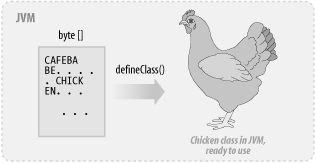Recipe 25.4 Constructing a Class from Scratch
ProblemYou need to load a class and run its methods. SolutionWrite and use your own ClassLoader. DiscussionA ClassLoader , of course, is a program that loads classes. One class loader is built into the Java Virtual Machine, but your application can create others as needed. Learning to write and run a working class loader and using it to load a class and run its methods is a nontrivial exercise. In fact, you rarely need to write a class loader, but knowing how is helpful in understanding how the JVM finds classes, creates objects, and calls methods. ClassLoader itself is abstract; you must subclass it, presumably providing a loadClass( ) method that loads classes as you wish. It can load the bytes from a network connection, a local disk, RAM, a serial port, or anywhere else. Or you can construct the class file in memory yourself, if you have access to a compiler. You must call this class loader's loadClass( ) method for any classes you wish to load from it. Note that it is called to load all classes required for classes you load (parent classes that aren't already loaded, for example). However, the JVM still loads classes that you instantiate with the new operator "normally" via CLASSPATH. When writing a class loader, your loadClass( ) method needs to get the class file into a byte array (typically by reading it), convert the array into a Class object, and return the result. What? That sounds a bit like "And Then a Miracle Occurs . . . " And it is. The miracle of class creation, however, happens down inside the JVM, where you don't have access to it. Instead, your ClassLoader has to call the protected defineClass( ) method in your superclass (which is java.lang.ClassLoader). This is illustrated in Figure 25-1, where a stream of bytes containing a hypothetical Chicken class is converted into a ready-to-run Chicken class in the JVM by calling the defineClass( ) method. Figure 25-1. ClassLoader in action What next?To use your ClassLoader subclass, you need to instantiate it and call its loadClass( ) method with the name of the class you want to load. This gives you a Class object for the named class; the Class object in turn lets you construct instances, find and call methods, etc. Refer back to Recipe 25.2. |
EAN: 2147483647
Pages: 409